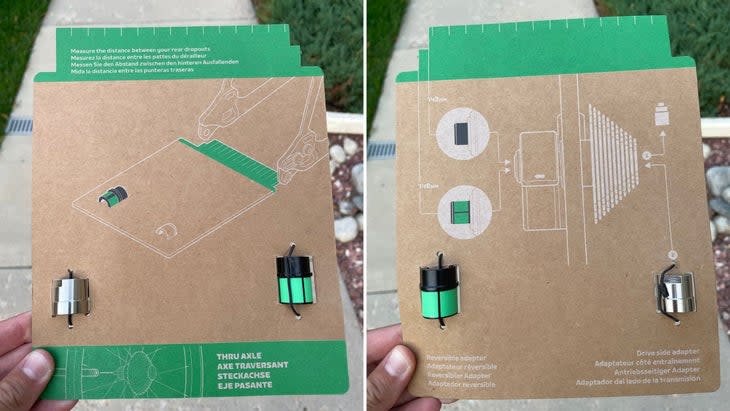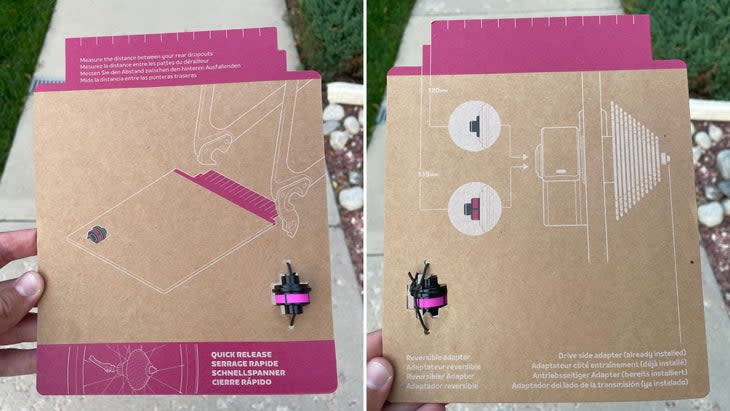First Impressions: The New Zwift Hub Smart Trainer
This article originally appeared on Triathlete
In 2014, Zwift took the market by storm with its gamified online cycling experience, forever upending the indoor cycling world for the better. For nearly 10 years, Zwift has done what Zwift does best: software. Until now.
Zwift is entering its hardware era with a bang by introducing the new Zwift Hub smart trainer, available October 3, 2022.
RELATED: The Smart Trainer Explainer
Zwift Hub Smart Trainer: The Basics
With a look and feel similar to most direct-drive (i.e., back wheel off) smart trainers, it's hard to believe that the Hub sells for just about half the price ($500) of its competitors, whose products sit in the $1,000+ range.
For a software company, Zwift thought of just about everything for its debut hardware. The Hub is easy to unpack and assemble, follows through on its promise of mechanical silence, and features an internal power meter and cadence monitor--again, all for $500 less than something like the extremely popular Wahoo KICKR.
Spec-wise, you get a 10-pound flywheel, 16% simulated grade, 1,800W max, +/- 2.5% power accuracy on the built-in power meter, and ANT+ FE-C, ANT+, and Bluetooth compatibility. Interestingly enough, the trainer is also compatible with pretty much all virtual training apps, so unlike other brands that do the software-first, hardware-follows thing, you're not trapped in the Zwift virtual ecosystem when you buy their trainer.
Below, we take a look at our first impressions of the unit with yet-to-market firmware. As the final October-released version may have software bugs worked out, we've kept this quick look mostly to the hardware side.
RELATED: Which Type of Zwifter Are You?
Zwift Hub Smart Trainer: The Good
The Hub is one of the fastest "unboxing to first ride" experiences on the market. Zwift gets bonus points for using cardboard-based packaging and as little plastic as possible, too.
Similar to other smart trainers, the rider must assemble two base bars on which the trainer sits. The cassette arrives already installed on the trainer (choose what type when you order), so the last thing to do is use Zwift's handy-dandy quick release or thru axle adapter cards to determine the size adapter you need to insert on the non-cassette side of the trainer.
While the card system may seem foreign, the instruction booklet clearly lays out how to use them, pictures and all. While the measurements may look confusing out of context, the quick-start guide is one of the simplest we've seen yet. It will be hard to mess up. And even if you do, simply pop the adapter out and flip it over to the other side. Easy.


Plug in the cord to both the trainer and the wall, open Zwift on your chosen software, and you're ready to ride. Zwift even includes a walkthrough of how to remove your back wheel and install it on the trainer's cassette for first-time direct-drive trainer users.
The real "wow" factor of the Hub is how quiet it is. Most smart trainers claim to be quiet enough that a rider can have a conversation, watch TV, or not disturb the neighbors when riding but fall through on that promise as soon as the watts tick up. Not the Hub.
The Hub truly remains whisper-quiet whether the athlete is completing an easy spin or the hardest intervals of their life. For those in apartments or who live with roommates, this trainer is a godsend.
RELATED: 8 Zwift Racing Tips for Improving Efficiency and Winning Events
Zwift Hub Smart Trainer: The OK
Fortunately, this section is short.
Similar to other trainers, the base bars of the actual trainer (the part with the cassette) are not attached to the trainer on arrival; consumers must screw them on.
While it was easy enough to use the color-coded key to match each bar to its correct spot and line up the screws, users must flip the trainer over in order to tighten each bolt. And, well, flipping over a heavy trainer with a circular top isn't the easiest task. You'll need to find some sort of configuration that allows you to balance the trainer upside down while holding the base bar in place long enough to secure the screw.
Or, if it's available to you, grab a friend and have them hold the trainer as you secure the bolts. That would make things significantly easier.
Once both bars are locked in place and the trainer is upright, it's clear that while there's no concern of the trainer tipping, the Hub isn't quite as sturdy as, say, a Wahoo KICKR. Mostly this is because the Hub weighs less--six pounds of which come from the flywheel alone. Its overall relative lightness may be a pro to some, though the lighter flywheel does give a slightly less realistic ride feel.
Elsewhere, the Hub felt slightly tippy when securing a bike onto its cassette, but was generally stable once on the bike and riding. There was no major concern of falling over once seated on the bike.
Lastly--and this is the tiniest of critiques --there is no handle by which to move the Hub. While it's easy and light enough to pick up by one of the base bars, a handle would be a nice feature to combat the awkwardness of currently trying to grasp the Hub when moving it. Is a handle worth the extra $400 to buy a trainer with one? You can decide.
Zwift Hub Smart Trainer: Conclusions
The Hub should have competitors on high alert. Its phenomenal price (which can also be financed for as low as $21/month, according to Zwift) and approachable setup and design make the Hub an immediate contender for those new to cycling and seasoned riders alike.
The digestible instructions (complete with illustrations!) and configurable initial setup make moving from trainer delivery to first ride possible in less than 30 minutes. Plus, the blissful silence of the trainer is a welcome reprieve from shouting over the mechanical whirr of other brands' hardware.
The Hub is ever-so-slightly tippy at the outset, but once a rider is situated, any concerns of stability fade away. In future models, we'd like to see the Hub add some sort of handle to make it a bit less annoying to move when needed.
RELATED: Get Ready For Indoor Training Season
For exclusive access to all of our fitness, gear, adventure, and travel stories, plus discounts on trips, events, and gear, sign up for Outside+ today.

